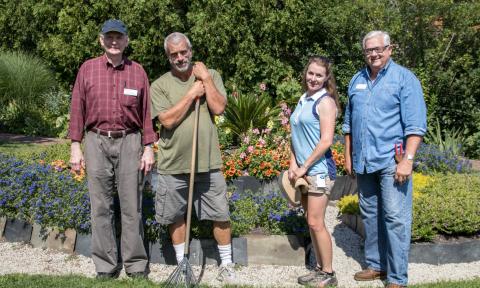Master Gardeners Help Steward History at Strawbery Banke Museum

Master Gardener Bill Keating is part of a group of volunteer Master Gardeners that help steward a group of historic gardens on the grounds of Strawberry Banke in Portsmouth, NH. Supporting the work of Erik Wochholz, Strawbery Banke’s Curator of Historic Landscapes, the volunteers started 10 years ago with a focus on the Victorian Children’s Garden and this year expanded their help to include the Goodwin Garden, a World War II Victory Garden, the Ethnobotanical Herb Garden, and the Victorian Hot House (or greenhouse). (Pictured left to right: Bill Keating, Glenn Szegedy, Emily Lannan and Terry Cook).

The Master Gardener volunteers at Strawbery Banke do more than the usual gardening tasks. “We interpret these gardens with museum visitors. We also share the sustainable practices we use,” says Master Gardener Bill Keating. Visitors to Strawbery Banke experience a 10-acre outdoor history museum dedicated to bringing 300+ years of American history to life. The gardens are part of that historical journey, and show changes in gardening habits from the time of European settlement to modern day.

“My father was a gardener, so maybe it’s a bit hereditary,” says Master Gardener Bill Keating. “Now I have too many gardens.” Keating, a Master Gardener since 2008, joined the volunteer program because of the opportunity to increase his knowledge, but also interact with the public. “I like the idea of doing, learning, sharing,” he says. For about 30 years, Keating has been an active gardener finding the practice a calming routine after a day at work. Keating’s pathway to the Master Gardener program, just like his passion for gardening, is common among the volunteer group.

The Victorian Children’s Garden has been the primary focus for Master Gardeners for almost a decade at Strawbery Banke. The garden features fun and interactive learning experiences with a Victorian tea garden, plants that tell time, a butterfly and fairy garden, a language of flowers gardens and a two-story naturalistic Victorian treehouse. While the treehouse would more likely be found in the woods of a country estate instead of an urban backyard, the structure provides a perspective on the appreciation for wilderness amidst industrialization during the Victorian period.
